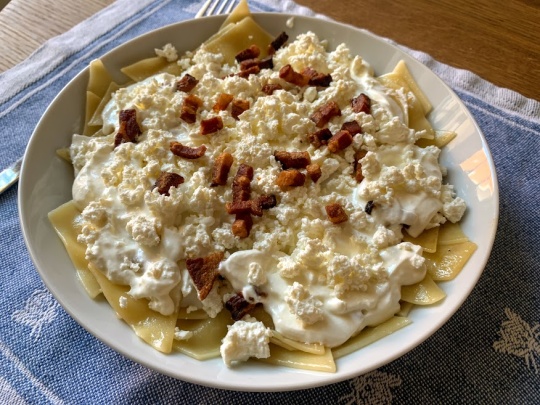
The túrós csusza is a late-medieval Hungarian dish that has remained well-liked ever since. It consists of slippery egg noodles smothered in sour cream and túró and sprinkled with crispy pork cracklings. The preparation is very simple, the key here is having good ingredients and using them with a generous hand. Hungarians often eat it as a second course after a fisherman's soup.
Ingredients
Yield: 4 servings; Total time: 20 minutes
225 grams (½ pound) smoked pork belly or fatback (or bacon), cut into small cubes, about 1 cm (½-inch) long. Remove skin.
500 grams (2 ¼ cups) Hungarian túró or crumbly cottage cheese
400 grams (1 ⅔ cups) sour cream
350 grams (¾ pound) dried pasta, ideally the flat and square-shaped Hungarian csusza. You can also use lasagne pasta, cracking the sheets into 1 ½-inch bits.
Pinch of salt
Directions
Step 1: Add the bits of pork belly or fatback (or bacon) into a large pan and render the fat on medium heat until meat turns golden-brown and crispy, about 8-10 minutes. When ready, remove the meat pieces with a slotted spoon and put aside in a small bowl. Keep the rendered fat in the skillet.
Step 2: In the meantime, bring a pot of salted water to a boil and cook pasta until al dente, about 7-8 minutes. Drain pasta, then add it to the skillet and mix well with the hot pork fat until pasta is slippery on all sides (you can even crisp the pasta edges a bit on medium-high heat).
Step 3: Turn heat to low, add sour cream, túró (cottage cheese), and a generous pinch of salt into the pan and combine well with the pasta.
Step 4: Spoon the pasta onto serving plates, sprinkle the crispy bits of pork cracklings on top, and serve while still hot.
Words of advice
Take care not to burn the pork cracklings. Burnt cracklings should be discarded and the túrós csusza isn’t the same without it.
I created these recipes with the help of nearly a dozen historical Hungarian cookbooks, adjusting ingredients, cooking times, and methods to reflect my own preferences and tastes of the current day. Do you have any feedback? Please let me know!